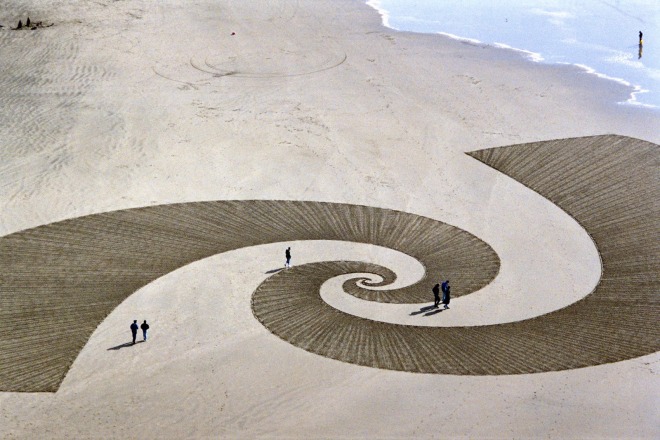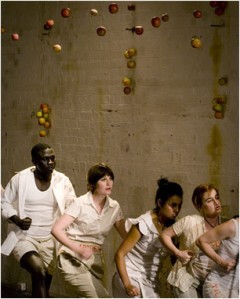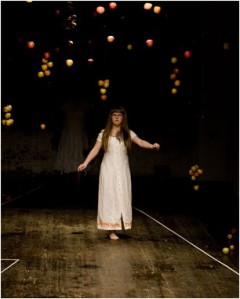People often ask me how I became interested in sustainability and design, and what triggered my decision to commence a PhD on the subject. Looking back, it’s difficult to pinpoint a single moment. Was it seeing my set thrown in a skip one too many times? Or perhaps feeling physically ill after using several cans of enamel spray paint to change the colour of a prop? Or watching several native trees being cut down solely for the purpose of stage decoration? No doubt each of things played a role.
However, like many designers, my interest in sustainability has grown out of an increasing appreciation of the scale of the environmental challenges our society faces.
I was always passionate about environmental issues. At certain times in my life I worked for environmental charity and advocacy groups, and became involved in a variety of community engaged projects. I tried hard to be a good environmental citizen in my day-to-day life; buying food from local suppliers, taking public transport, turning off lights and recycling. Yet when I walked in the theatre these basic practices went out the window. Theatre, it seemed, gave me a licence to do the things I wouldn’t do at home. Perhaps it was because I was never taught to critique my practices in the theatre from an environmental perspective, or query the consequences of my design. Decadence wasn’t questioned in my era of design education, and in fact it was encouraged if the budget would allow for it. We were trained with the end result in mind. How we got to opening night or what happened to our sets and costumes after the production ended was simply not a priority.
And then about 6 years ago I had the opportunity to work as an exhibition designer at the Melbourne Museum (in my home state of Victoria, Australia). The job came with a unique selling point: a team of environmentally conscious graphic, interior and industrial designers who were keen to put sustainability at the heart of what they did. While the design studio was still in the early stages of implementing a sustainability plan, the atmosphere was alive with possibility and activity. This was a completely new world for me, and one that profoundly changed my perspective.
Part of my job at the museum was to conduct research into sustainable strategies and products – a challenging task for any designer, especially one with no prior knowledge or experience in this area. It was here that I caught the research bug, because once I started, it was like opening a Pandora’s box. By the time my job at the Museum ended and I returned to stage design, I had already become acutely aware of the disconnect between my values and my actions. Suddenly I had lots of questions about the materials, products and life-cycle of my sets and costumes. I realised that despite only scratching the surface on the sustainability agenda at the Museum, I already knew too much. I couldn’t go back.
At that time, there wasn’t much available on ecological design for performance. I clearly remember searching the web, desperate for information, and being somewhat dismayed at the lack of resources on the subject. While I found mountains of material on environmentally sustainable practice from other design fields, there seemed to be a gaping hole when it came to theatre. Why weren’t we thinking about the consequences of what we design? Why had I only started to question it myself now? This questioning sparked a series of investigations into my own practice and finally the commencement of my PhD on the paradigm and practice of ecological design in the Performing Arts in 2011. And here I am, more than 3 years in, still riffling through the Pandora’s box of challenges and opportunities that ecological design presents.
But of course I’m not the only one who has caught the sustainability bug. Theatre has come a long way since the early days of my sustainable research in 2008. Today, there are many initiatives around the world that focus on sustainability and performance.
There are amazing people all over, doing small things with big ideas, and starting to change the way we make theatre. There is a whiff of revolution in the air. Take the 2013 World Stage Design Congress as a case in point. Even just 6 years ago, it would have been unimaginable that the Congress would have its own sustainability section. But sure enough in Cardiff that is exactly what they had.
Seemingly small steps such as these are in fact giant leaps for this burgeoning new field, and it is intensely exciting to be a part of it. It is true, there are plenty of challenges ahead. But my hope is that the Performing Arts will ultimately accept environmental sustainability as a key value, and that “ecological design” will one day be synonymous with “good design”. Design that is in tune with our values, and considers its relationship to our environment and future. It might seem utopian now, but we are definitely on the right path.

My first project investigating ecological design for performance was for “One is Warm in Winter and the Other Has a Better View” with Platform Youth Theatre in 2009 (shown here). The design featured an installation of over 700 apples, the majority of which were suspended from the ceiling. The apples were sourced from local farmers and were donated to the Collingwood Children’s Farm after the season ended. Care was taken to avoid the use of glues or toxic substances in the hanging and preservation of the apples; instead apples were strung with fishing line attached to screws that held the apples securely in place. After 10 days in the theatre, a lovely apple scent developed and filled the space, creating a surprising multi-sensory layer to the production
Theatre Photos: Sophie Neate
This post was originally published as part of Julie’s Bicycle blog posts.






